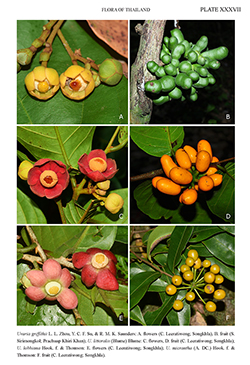e-Flora of Thailand
Volume 16 > Part 1 > Year 2022 > Page 304 > Annonaceae > Uvaria
10. Uvaria griffithii L.L.Zhou, Y.C.F.Su & R.M.K.Saunderswfo-0000744962
Syst. Biodivers. 7: 255. 2009. Plate XXXVII: A–B.
Accepted Name : This is currently accepted.
Synonyms & Citations :
Description : Climber to 25 m high. Young shoots sparsely tomentose, quickly becoming subglabrous, bark black and striate. Leaves membranous or coriaceous, narrowly obovate, 10–15 by 4–6 cm, base narrowly cordate to cordate, apex acute to short-acuminate, hairs erect, sub-tomentose over upper midrib but otherwise glabrous above, midrib quickly becoming sparsely pubescent to glabrous, sparsely pubescent to subglabrous on midrib but otherwise subglabrous to glabrous below, secondary veins 9–15 per side; petioles 5–7 by 1.2–2.5 mm, warted below. Inflorescences leaf-opposed, 1–4-flowered, plants sometimes cauliflorous, peduncle elongate, ca 20–50 mm long by 1.5 mm in diam., pedicels 20–30 mm long. Sepals 3, valvate, free, broadly ovate, 5 mm wide by 3 mm long, often reflexed at maturity. Petals in two whorls of 3, green or yellow, concave, thickened basally and with prominent transverse foliations on outer surface; outer petals broadly ovate, ca 5 by 5 mm; inner petals ovate, 5 by 4 mm, base constricted. Stamens numerous, cuneate, 2–2.5 mm long, anther connective apex ca 0.5–0.7 mm long, incurved, papillate, papillae often hair-like, filament absent. Carpels numerous, ca 3–4 mm long, ovaries tomentose, stigmas glabrous, elongate, conical, ca 1–1.25 mm long, U-shaped in section; ovules 5–6 in 2 rows. Monocarps 2–10+, green-yellow, ovoid to oblongoid but irregular in shape due to compression of pericarp around seeds, 2.5–4 by 1–2 cm, glabrous, stipe ca 20 mm long, 2.5 mm in diam.; pericarp thickened. Seeds 4–6, in two rows but becoming irregularly arranged in mature fruit.
Thailand : SOUTH-WESTERN: Prachuap Khiri Khan; PENINSULAR: Nakhon Si Thammarat, Songkhla, Pattani (Khao Kalakiri).
Distribution : Peninsular Malaysia (type).
Ecology : Rain forests, sea level to 300 m alt. Flowering and fruiting throughout the year.
Notes: The fruit of Uvaria griffithii resembles that of U. pierrei, however the oblong leaves with obtuse to retuse apices of the latter species are very different.

